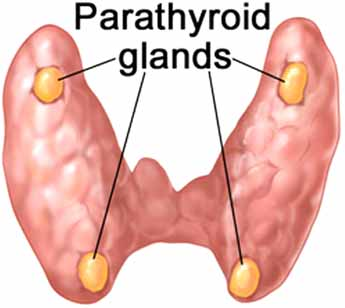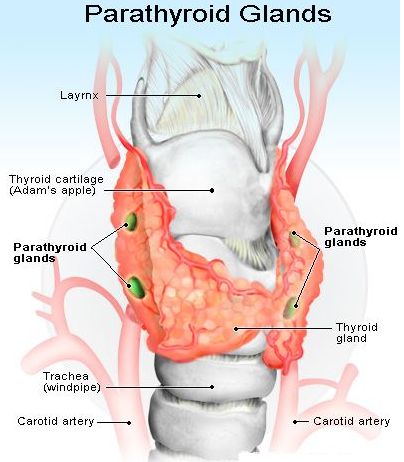Parathyroid glands functions to produce the parathyroid hormone that plays a key role in the regulation of calcium levels of blood. It is essential to maintain an adequate level of calcium in the human body, as any deviation from the normal levels can cause nerve and muscle problems.

Anatomy of Parathyroid Glands
The parathyroid glands consist of the two small pairs, which are oval. They are located in the neck, located next to the two thyroid gland lobes. Usually, the size of each gland is like the size of a pea. Occasionally, the parathyroid glands can be small like the size of the rice grain. The normal color of the parathyroid glands is like the color of the spicy yellow mustard.
Functions of Parathyroid Glands
The parathyroid hormones stimulate the release of calcium by bones to the bloodstream, absorption of calcium from the food, conservation of the calcium minerals by the bones, and stimulation of cells in the kidney for the transformation of the weak forms of vitamin D to the strongest forms. The normal parathyroid glands work like the thermostat and keep the blood calcium levels tightly controlled.
The main targeted organs of the parathyroid hormones are the kidneys and the bones. If someone is not taking enough calcium in the diet and is not even having enough amount of vitamin D, then the circulation of the calcium level significantly falls and the parathyroid glands cause the production of more parathyroid hormones. In this way, the parathyroid glands bring the calcium level in the blood back to normal.

How Calcium Level in Blood is Regulated by Parathyroid Glands
When the parathyroid develop the tumors, this situation is known as hyperparathyroidism which causes the release of too much hormone, and blood calcium levels are increased too much extent. Calcium is the only element in the human body that has its own regulatory system the parathyroid glands. These glands regulate the calcium in a very narrow range of the body so that all the muscular and the nervous systems can properly function. Every minute of every day, the amount of calcium is measured and is regulated in the human body by the parathyroid glands. If the amount of calcium is decreased by the optimum level, then parathyroid glands make the parathyroid hormones which penetrates to the bones and takes some amount of the calcium out of the bones and push it to the bloodstream. When the amount of calcium is increased in the blood than the required levels, the parathyroid gland is shut down and stop synthesizing the parathyroid hormones.